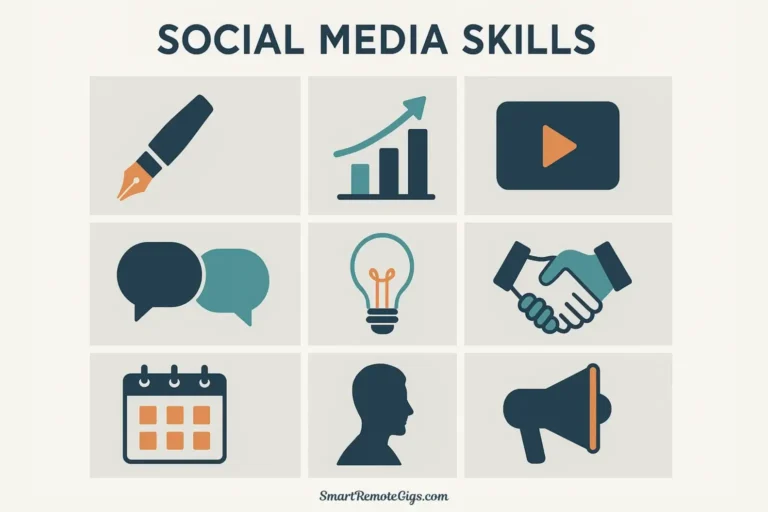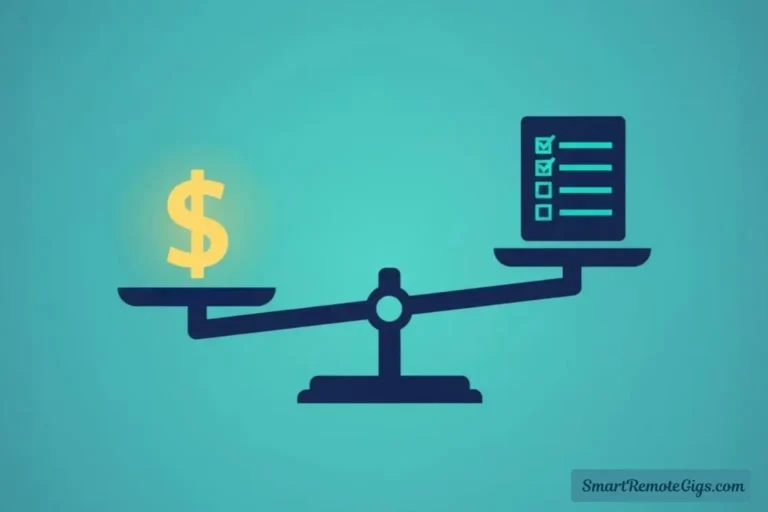The world of work has transformed dramatically, and few careers embody this shift quite like the remote social media manager. With businesses increasingly recognizing that their online presence can make or break their success, demand for skilled social media professionals has skyrocketed. Better yet, this creative, dynamic role offers something many traditional careers don’t: the freedom to work from anywhere.
Whether you’re a recent graduate exploring entry-level social media manager jobs, a career changer seeking flexibility, or a marketing professional looking to transition to remote work, this guide provides everything you need. We’ll walk you through the complete journey—from understanding what social media managers actually do, to building a portfolio that stands out, to landing interviews and negotiating offers.
By the end of this comprehensive roadmap, you’ll have a clear action plan to break into remote social media manager jobs and build a thriving career on your own terms.
Part 1: What is a Remote Social Media Manager? (The Foundation)

Before diving into how to become a social media manager, let’s establish exactly what this role entails and why it’s become one of the most sought-after remote positions in 2025. For an even more granular breakdown of every task and strategic function, check out our deep dive: What Does a Remote Social Media Manager Do?
A remote social media manager is responsible for building, managing, and growing a brand’s presence across social media platforms—all while working from home or any location with a reliable internet connection. This isn’t just about posting pretty pictures on Instagram. Modern social media managers are strategic marketers who blend creativity with data analysis to drive real business results.
Core Responsibilities & Daily Tasks
The day-to-day work of a social media manager is surprisingly diverse, which is part of what makes the role so engaging. Here are the primary responsibilities you’ll typically handle:
- Strategy Development: Create comprehensive social media strategies aligned with broader marketing and business objectives. This includes identifying target audiences, selecting platforms, and establishing key performance indicators (KPIs).
- Content Creation & Curation: Develop engaging posts, graphics, videos, and stories that resonate with your audience. This involves writing compelling copy, coordinating with designers, and sometimes creating visual content yourself.
- Community Management: Respond to comments, messages, and mentions in a timely, on-brand manner. Build genuine relationships with followers and turn casual observers into brand advocates.
- Analytics & Reporting: Track performance metrics, analyze what’s working (and what isn’t), and prepare reports that demonstrate ROI to stakeholders. Data literacy is increasingly crucial in this role.
- Campaign Management: Plan and execute paid social advertising campaigns, including budget management, audience targeting, and A/B testing.
- Trend Monitoring: Stay current with platform updates, emerging trends, viral content formats, and competitor activities to keep your brand relevant.
- Cross-Team Collaboration: Work with marketing, customer service, product, and sales teams to ensure social media efforts support overall company goals.
This diversity of tasks makes the role incredibly engaging. To see how these responsibilities fit into a real workday, read our guide: A Day in the Life of a Remote Social Media Manager.
How Much Do Remote Social Media Managers Make? (Salary Expectations)
Salary is often the first question aspiring social media managers ask—and for good reason. The financial viability of this career path matters, especially if you’re considering a career change or leaving a stable job.
According to recent data from Glassdoor and Payscale, remote social media manager salary ranges vary based on experience level, specialization, and whether you work as an employee or freelancer:
Entry-Level (0-2 years experience): $40,000 – $55,000 annually for full-time positions. Freelancers typically charge $25-$50 per hour when starting out.
Mid-Level (3-5 years experience): $55,000 – $75,000 annually. Experienced freelancers can command $50-$100 per hour.
Senior-Level (6+ years experience): $75,000 – $110,000+ annually, with some senior strategists and directors earning significantly more. Top-tier freelance consultants may charge $100-$200+ per hour.
The beauty of remote work is that you can often earn coastal salaries while living in more affordable areas, significantly increasing your purchasing power. Additionally, many remote social media jobs offer benefits like unlimited PTO, professional development budgets, and home office stipends.
For a comprehensive, data-driven analysis of salary trends, which skills command premium pay, and expert predictions for the future of the profession, be sure to read our full 2025 State of Remote Social Media Careers Report.
Freelance vs. Full-Time: Which Path is Right for You?
One of the unique aspects of social media management is that both freelance and traditional employment paths are highly viable. Each has distinct advantages depending on your circumstances, personality, and career goals.
Full-Time Employment
Pros:
Cons:
Best for: Those who value security, prefer focusing on one brand at a time, and want structured career advancement.
Freelancing
Pros:
Cons:
Best for: Self-motivated individuals who enjoy variety, are comfortable with income variability, and want location independence.
Many social media managers start with one path and transition to the other—or blend both by maintaining a full-time position while freelancing on the side. There’s no universally “right” choice, only what aligns with your current needs and long-term vision.
Part 2: Mastering the Essential Skills & Tools

Success as a remote social media manager requires a unique combination of creative and analytical abilities. The good news? Most of these social media manager skills can be learned and developed with deliberate practice, even if you’re starting from remote social media jobs no experience. For a deeper dive into each competency, see our definitive list of The Top 10 Skills Every Remote SMM Needs.
The Top 5 Hard Skills You Must Have
1. Platform Expertise & Best Practices
Each social media platform has its own culture, content formats, algorithm quirks, and best practices. You don’t need to be an expert on every platform immediately, but you should develop deep knowledge of at least 2-3 major platforms. Understand Instagram’s emphasis on visual storytelling, LinkedIn’s professional networking dynamics, TikTok’s trend-driven content, Twitter’s real-time conversation style, and Facebook’s community-building features. Stay updated on algorithm changes and new features that could impact your strategy.
In fact, specializing in high-growth platforms like short-form video has become a lucrative career path on its own. To see which companies are actively seeking these skills, check out our list of Top Companies Hiring Remote TikTok & Reels Specialists.
2. Content Creation & Copywriting
The ability to write compelling copy that drives engagement is non-negotiable. This means understanding how to craft attention-grabbing headlines, write persuasive calls-to-action, adapt tone for different platforms and audiences, and tell stories that resonate emotionally. You should also develop basic graphic design skills using tools like Canva or Adobe Creative Suite, understand video editing fundamentals, and know how to create accessible content with proper alt text and captions.
3. Analytics & Data Interpretation
Modern social media management is as much science as art. You need to be comfortable tracking and analyzing metrics like reach, engagement rate, click-through rate, conversion rate, and ROI. Learn to identify patterns in data, understand what metrics actually matter for different goals, create clear reports that communicate insights to non-technical stakeholders, and use data to inform future strategy rather than just reporting what happened.
4. Paid Social Advertising
Organic reach on most platforms has declined significantly, making paid advertising knowledge increasingly valuable. Familiarize yourself with Facebook Ads Manager (which also powers Instagram ads), understand audience targeting options and how to build custom audiences, learn A/B testing methodologies to optimize campaigns, develop budget management skills, and understand basic ROAS (Return on Ad Spend) calculations.
5. SEO & Content Strategy Fundamentals
While social media and search engine optimization are distinct disciplines, they increasingly overlap. Understanding basic SEO principles helps you create more discoverable content, use strategic keywords in social profiles and posts, optimize for platform-specific search features, and recognize how social signals can indirectly impact search rankings.
The Top 5 Soft Skills That Get You Hired
Technical skills get your foot in the door, but soft skills determine how far you’ll advance and how much clients or employers value working with you.
1. Strategic Communication
You’re the voice of the brand, which means exceptional written and verbal communication is paramount. You need to adapt your communication style for different audiences, clearly articulate strategy and results to stakeholders, handle crisis situations with composure and sensitivity, and collaborate effectively across departments and time zones in a remote environment.
2. Adaptability & Continuous Learning
Social media evolves at breakneck speed. Platforms rise and fall, algorithms change monthly, and trends emerge overnight. Successful social media managers embrace change rather than resist it. They’re curious lifelong learners who actively seek out new information, experiment with emerging platforms and features, and aren’t afraid to pivot strategies when circumstances change.
3. Organization & Time Management
Managing multiple platforms, content calendars, campaigns, and competing priorities requires exceptional organizational skills. You’ll need to prioritize effectively when everything feels urgent, manage your time autonomously without constant supervision, use project management tools to stay on top of deliverables, and maintain consistent quality even when juggling multiple responsibilities.
4. Creativity & Innovation
Standing out in crowded social feeds requires fresh ideas and creative thinking. Develop your ability to generate original content concepts, put unique spins on trending formats, think outside the box when traditional approaches aren’t working, and balance creativity with strategic objectives rather than being creative for creativity’s sake.
5. Proactivity & Problem-Solving
Remote work rewards self-starters who don’t need hand-holding. Anticipate potential issues before they become crises, propose solutions rather than just identifying problems, take initiative on projects without being asked, and stay one step ahead by monitoring trends and competitor activities.
The Tools of the Trade: Your Remote SMM Tech Stack
Professional social media managers rely on a suite of tools to work efficiently and effectively. While you don’t need to master every tool on day one, familiarizing yourself with industry-standard platforms will make you a more competitive candidate.
Content Scheduling & Management: Buffer, Hootsuite, Later, Sprout Social, and Meta Business Suite allow you to plan, schedule, and publish content across multiple platforms from a single dashboard. These tools save hours each week and ensure consistent posting schedules.
Analytics & Reporting: Native platform analytics (Instagram Insights, Twitter Analytics, etc.) provide valuable data, but third-party tools like Google Analytics, Iconosquare, and Sprout Social offer more comprehensive reporting and competitive analysis features.
Graphic Design: Canva has become the go-to tool for non-designers creating social graphics, while professionals often use Adobe Creative Suite (Photoshop, Illustrator, Premiere Pro) for more advanced work.
Project Management & Collaboration: Tools like Trello, Asana, Monday.com, and Notion help you organize content calendars, track campaign progress, and collaborate with team members across time zones.
AI & Automation: ChatGPT and other AI writing assistants can help with brainstorming and drafting (though human editing remains essential), while tools like Zapier automate repetitive tasks between different platforms.
The specific tools you use will often depend on employer or client preferences, but demonstrating familiarity with multiple options in your social media manager portfolio shows versatility and technical competence.
Part 3: Building Your Application Arsenal (How to Stand Out)

Having the right skills matters, but in a competitive job market, you need to effectively demonstrate those abilities. Your portfolio, resume, and cover letter are your marketing materials—and as a social media professional, marketing yourself should be your specialty.
How to Build a Killer Portfolio (Even with No Experience)
The portfolio challenge creates a catch-22 for many aspiring social media managers: you need experience to get hired, but you need to get hired to gain experience. The solution is to create your own experience through strategic portfolio projects.
Start with a Personal Brand: Your own social media presence is your first portfolio piece. Choose 1-2 platforms where your target employers are active (likely LinkedIn and Instagram or Twitter) and treat them professionally. Post consistently about social media marketing, share industry insights and tips, engage thoughtfully with others’ content, and demonstrate the strategies you’d use for clients. If potential employers look you up and find inactive or unprofessional profiles, it raises immediate red flags.
Create Mock Campaigns: Select 2-3 fictional or real small businesses in different industries and develop complete social media strategies for them. Include audience research and persona development, platform recommendations with reasoning, a month’s worth of sample content with captions and visual mockups, a content calendar showing posting schedule and themes, and key metrics you’d track to measure success. Present these as case studies in a PDF or simple website.
Offer Free or Discounted Work Strategically: Reach out to local nonprofits, small businesses owned by friends or family, or passion projects that align with your interests. Even a short 2-3 month engagement provides real experience, tangible results to reference, testimonials for your portfolio, and valuable lessons about client management. Just ensure you set clear boundaries around scope and timeline.
Document Your Process: Employers don’t just want to see finished products—they want to understand how you think. Create a blog post or video walking through your strategy development process, showcase before-and-after examples of content you’ve improved, or explain how you’d handle a challenging scenario like a PR crisis or negative reviews.
Show Results, Not Just Pretty Pictures: Anyone can create attractive graphics. What sets professional social media managers apart is the ability to drive meaningful outcomes. Whenever possible, include metrics in your portfolio: “Increased engagement rate by 47% over three months,” “Grew follower count from 500 to 2,300 in six months,” or “Generated 85 qualified leads through targeted Facebook campaigns.”
For a detailed, step-by-step guide to building portfolio projects from scratch, check out our article on 5 Projects to Build Your SMM Portfolio From Scratch.
Crafting a Remote-Ready, Keyword-Optimized Resume
Your resume needs to accomplish two tasks: get past applicant tracking systems (ATS) and impress human hiring managers. Here’s how to optimize for both.
Use Keywords Strategically: Review several job postings for roles you’re targeting and note frequently mentioned skills and qualifications. Incorporate these exact phrases naturally throughout your resume. For remote positions, highlight terms like “remote collaboration,” “asynchronous communication,” “self-motivated,” and specific remote tools you’ve used (Zoom, Slack, etc.).
Quantify Your Achievements: Transform vague responsibilities into concrete accomplishments. Instead of “Managed social media accounts,” write “Grew Instagram following from 1,200 to 8,500 in 8 months while maintaining 4.2% average engagement rate.” Numbers provide context and demonstrate impact.
Emphasize Remote Work Skills: If you’ve worked remotely before (even in a different field), highlight it. If you haven’t, emphasize transferable skills like self-direction, written communication, and tech proficiency. Mention any experience collaborating across time zones or managing projects independently.
Include a Skills Section: Create a dedicated section listing relevant hard skills (social media platforms, tools, analytics software) and key soft skills. This helps with ATS optimization and allows hiring managers to quickly assess your qualifications.
Format for ATS Compatibility: Use a clean, simple layout without fancy graphics or unusual formatting. Stick to standard section headers (Experience, Education, Skills). Save and submit as a .docx or PDF (check the job posting for preferred format). Avoid headers, footers, tables, and text boxes which can confuse ATS software.
Writing a Cover Letter That Gets Noticed
Many applicants skip the cover letter or submit generic templates. This is your opportunity to differentiate yourself through personality and storytelling.
Open with a Hook: Skip “I am writing to apply for…” Instead, open with something memorable: a relevant accomplishment, your genuine enthusiasm for the company’s brand, or a compelling reason why you’re transitioning into this field.
Demonstrate Company Research: Reference specific aspects of their social media presence. Perhaps you noticed their Instagram Stories are underutilized, or you love their Twitter voice but see opportunities to increase engagement. This shows initiative and genuine interest rather than mass-applying.
Tell Your Story: If you’re making a career change or entering remote social media jobs no experience, address it directly but positively. Connect your previous experience to social media management: “While working in hospitality, I developed crucial skills in customer service and real-time problem-solving—abilities that translate directly to community management.”
Show Personality: Social media is about human connection, so let your personality shine through your writing. Use a conversational tone (while remaining professional) and let hiring managers get a sense of who you are, not just what you’ve done.
End with a Clear Call-to-Action: Close by expressing enthusiasm for the next step: “I’d love to discuss how my data-driven approach and creative content strategies could support [Company]’s Q2 growth goals. I’m available for a conversation at your convenience.”
Part 4: Where to Find the Best Remote Social Media Jobs

Knowing where to look can cut your job search time in half. Different platforms serve different purposes, and a strategic approach involves using multiple channels simultaneously.
Niche Remote Job Boards
Specialized remote job boards aggregate positions from companies that are serious about remote work—meaning you won’t waste time on listings that turn out to be “remote” only within one state or require occasional office visits.
We Work Remotely and Remote.co focus exclusively on remote positions across various fields including marketing and social media. FlexJobs is a paid service ($14.95/month) that vets every listing to eliminate scams and ensures quality remote opportunities. Working Nomads curates remote jobs and sends daily email digests based on your preferences.
These niche boards typically have less competition than major job sites, and companies posting there are genuinely committed to remote work culture.
International & Cross-Border Opportunities
The beauty of remote work is that it opens up global opportunities. Many US-based companies, for example, are now actively hiring international talent. However, this involves navigating different legal contracts, tax systems, and payment methods. For professionals based in the UK, we’ve created a dedicated guide on How to Get a Remote US Social Media Job that covers these exact challenges.
General Job Boards (and How to Filter Them)
Major platforms like Indeed, LinkedIn, and Glassdoor have extensive listings but require more filtering. Use advanced search features to specify “remote” or “work from home” in location fields. Set up job alerts with specific keywords like “remote social media manager,” “social media coordinator remote,” or “digital marketing specialist remote” so new listings come directly to your inbox.
LinkedIn deserves special attention because it’s both a job board and a networking platform. Optimize your profile with relevant keywords, engage with content in your industry, follow companies you’d like to work for, and turn on the “Open to Work” feature to signal your availability to recruiters.
Freelance Marketplaces (Upwork, Fiverr, etc.)
If you’re interested in freelancing, platforms like Upwork, Fiverr, and Freelancer connect independent contractors with clients. While these marketplaces are competitive and often undervalued at first, they provide opportunities to build experience, testimonials, and a client base.
Success on freelance platforms requires a complete profile showcasing your skills and portfolio, competitive but sustainable pricing (don’t undervalue yourself long-term), customized proposals rather than templates, and excellent communication and customer service to earn 5-star reviews.
Consider starting with smaller projects to build reviews, then gradually increase rates as you establish credibility.
The Hidden Job Market: Networking & LinkedIn
Research suggests that 70-80% of jobs are never publicly advertised. Accessing this “hidden job market” requires proactive networking rather than passive application submission.
Leverage Your Existing Network: Inform friends, family, former colleagues, and college alumni that you’re seeking remote social media manager jobs. Many people are happy to help or make introductions if they know what you’re looking for.
Engage Authentically on LinkedIn: Rather than cold messaging strangers asking for jobs, build genuine relationships by commenting thoughtfully on posts, sharing valuable content, participating in industry groups, and connecting with people whose work you admire. When opportunities arise, you’ll already have established rapport.
Attend Virtual Industry Events: Webinars, Twitter Spaces, and online conferences provide networking opportunities. Participate actively by asking questions and following up with speakers or attendees afterward.
Direct Outreach to Companies: Identify companies whose values and work align with yours, even if they don’t have posted openings. Send a well-crafted email expressing your admiration for their work and interest in future opportunities. Sometimes companies will create positions for the right candidate.
For a curated list of the best platforms to streamline your search, see our guide to The 10 Best Remote Job Boards.
Part 5: Nailing the Interview & Getting the Offer

You’ve landed an interview—congratulations! Now it’s time to convert that opportunity into an offer. Remote interviews have unique considerations beyond traditional in-person meetings.
Preparing for the Remote Video Interview
Technical preparation is crucial for remote interviews. Nothing undermines your credibility faster than audio issues, poor lighting, or connectivity problems.
Test Your Technology: Ensure your computer, camera, and microphone work properly. Test the specific video platform (Zoom, Google Meet, Microsoft Teams) they’ll use. Have a backup plan—a phone with good data connection—in case your internet fails. Close unnecessary applications to prevent notifications from interrupting.
Optimize Your Environment: Choose a quiet location with minimal background noise and distractions. Position your camera at eye level (stack books under your laptop if needed). Ensure your face is well-lit, ideally by natural light from a window or with a ring light. Frame yourself so you’re centered with some space above your head. Create a clean, professional background—a plain wall works perfectly.
Dress Professionally: Even though you’re at home, dress as you would for an in-person interview. This puts you in a professional mindset and shows respect for the opportunity. Avoid busy patterns or logos that could be distracting on camera.
Prepare Your Materials: Have your resume, portfolio, notes about the company, and questions for the interviewer readily accessible but off-camera. Keep a notepad handy for taking notes. Have a glass of water within reach.
Practice Virtual Communication: Video communication feels different than in-person conversation. Make “eye contact” by looking at the camera rather than the screen. Speak slightly slower and more deliberately than usual. Use hand gestures naturally but keep them within frame. Build in brief pauses before responding to account for any audio delay.
Common Interview Questions (and How to Answer Them)
Preparation for predictable questions allows you to craft compelling responses that showcase your value.
“Walk me through your social media management process from strategy to execution.” This question assesses your strategic thinking and organizational skills. Structure your answer chronologically: Start with research (understanding brand, audience, competitors), move through strategy development (platform selection, content themes, goals), discuss execution (content creation, scheduling, community management), and end with analysis (tracking metrics, reporting, iterating). Demonstrate that you don’t just post randomly—you follow a deliberate, results-oriented process.
“How do you measure success on social media?” This reveals whether you understand that vanity metrics (likes, followers) aren’t always meaningful. Discuss aligning metrics with business objectives: brand awareness might track reach and impressions, lead generation focuses on link clicks and conversions, and community building emphasizes engagement rate and sentiment. Mention specific tools you use for tracking and how you translate data into actionable insights.
“Describe a time when you had to handle a social media crisis or negative feedback.” Use the STAR method (Situation, Task, Action, Result) to structure your response. Show that you remain calm under pressure, respond promptly and professionally, take conversations private when appropriate, and learn from incidents to prevent recurrence. If you lack direct experience, walk through how you’d hypothetically handle a specific scenario.
“What social media trends are you most excited about right now?” This assesses whether you stay current with industry developments. Discuss 2-3 recent trends or platform updates, explain why they’re significant, and importantly, how they could be leveraged strategically. This isn’t about name-dropping buzzwords—it’s about demonstrating strategic thinking about emerging opportunities.
“Why do you want to work remotely?” Be honest but strategic. Focus on productivity benefits (fewer distractions, flexible scheduling allowing deep work), lifestyle alignment (better work-life balance, location independence), and your self-motivation rather than just avoiding commutes. Provide evidence of your remote work success if you have it.
“Do you have any questions for us?” Always have questions prepared. This demonstrates genuine interest and helps you evaluate if the role is a good fit. Ask about team structure and who you’d work with, what success looks like in the first 90 days, what challenges the company faces with social media currently, what professional development opportunities exist, or how the company supports remote work culture. Avoid asking about salary or benefits in initial interviews unless they bring it up.
How to Negotiate Your Salary and Benefits
Many people, especially those entering entry-level social media manager jobs, feel uncomfortable negotiating. However, negotiation is expected and respected when done professionally.
Do Your Research: Before any salary discussion, research typical compensation for your experience level and location (even for remote roles, location sometimes factors in). Use resources like Glassdoor, Payscale, and LinkedIn Salary to establish a reasonable range.
Wait for the Offer: Don’t bring up salary in initial interviews. Let them make the first offer, which establishes the baseline for negotiation.
Negotiate the Entire Package: Salary is important, but remote positions offer other valuable benefits. Consider professional development budgets, equipment stipends, unlimited PTO, flexible hours, stock options, or bonuses. Sometimes companies have more flexibility on benefits than base salary.
Use Data and Value, Not Personal Need: Frame negotiations around market rates and the value you bring rather than personal circumstances. “Based on my research and the scope of responsibilities, I was expecting something in the $60,000-$65,000 range” is more effective than “I need more because of my rent.”
Be Gracious and Professional: Even if the initial offer is lower than hoped, express gratitude for the offer before negotiating. Use collaborative language: “I’m excited about this opportunity. Is there any flexibility on…?” rather than ultimatums. Be prepared to walk away if the compensation truly doesn’t meet your needs, but do so respectfully.
Get Everything in Writing: Once you’ve reached agreement, ensure all terms are documented in an official offer letter before giving notice at a current job or declining other opportunities.
Frequently Asked Questions (FAQ)
Do you need a degree to be a social media manager?
No, a degree is not strictly required to become a remote social media manager. While some employers prefer candidates with degrees in marketing, communications, journalism, or related fields, many prioritize demonstrated skills and results over formal education. Your portfolio, practical experience, and ability to drive measurable outcomes matter more than credentials.
That said, relevant coursework or certifications can strengthen your candidacy, especially for entry-level social media manager jobs where you have limited professional experience to showcase. Consider free or affordable options like Google Digital Marketing Certification, HubSpot Social Media Certification, Meta Blueprint courses, or Hootsuite Academy programs. These demonstrate commitment to professional development and provide foundational knowledge.
Ultimately, social media management is a performance-based field. Employers care most about whether you can create engaging content, build communities, and deliver ROI—abilities best proven through your portfolio and past results rather than a diploma.
How can I get a remote social media job with no experience?
Breaking into remote social media jobs no experience requires creativity and initiative, but it’s absolutely possible. Start by building your personal brand across 1-2 platforms, treating your own profiles as your first client and demonstrating the strategies you’d use professionally.
Create a portfolio using mock campaigns for fictional businesses or offer your services to small local businesses, nonprofits, or friends’ passion projects in exchange for testimonials and case studies. Even short-term volunteer work provides real experience you can reference.
Develop in-demand skills through free online courses from platforms like HubSpot, Google, and Coursera. Consider starting with freelance platforms like Upwork or Fiverr where you can take on small projects to build your reputation, reviews, and experience before pursuing full-time positions.
Network actively by engaging with social media marketing content on LinkedIn, joining relevant Facebook groups or Discord communities, and attending virtual industry events. Many people find their first opportunities through connections rather than cold applications.
Finally, tailor your applications carefully. Rather than mass-applying, research each company and customize your cover letter to demonstrate genuine interest and explain how your transferable skills from previous work (customer service, writing, visual design, data analysis) apply directly to social media management.
For an actionable checklist to guide you, follow our 4-Week Plan to Land a Remote Social Media Job with No Experience.
Can I be a remote social media manager part-time?
Yes, many remote social media manager jobs are available on a part-time or contract basis. This flexibility makes social media management ideal for parents, students, side-hustlers, or anyone seeking supplemental income without full-time commitment.
Freelancing naturally accommodates part-time work since you control your client load and hours. Many small businesses, solopreneurs, and startups need social media management but don’t have the budget or workload for a full-time position, creating abundant part-time opportunities.
When seeking part-time employment rather than freelancing, be explicit in your job search filters and applications about your availability. Some companies offer job-share arrangements or specifically hire part-time remote team members.
The key to success as a part-time social media manager is exceptional organization and time management. You’ll need to work efficiently, communicate clearly about availability, and potentially batch tasks to maintain consistency despite limited hours. Many professionals eventually build part-time work into full-time income by managing multiple clients simultaneously.
What is the career path for a social media manager?
The career trajectory for social media managers offers multiple paths depending on your interests and strengths. A typical progression might start with an entry-level social media coordinator position handling content creation and community management under senior supervision.
From there, you might advance to social media manager, taking on strategic responsibilities, campaign planning, and possibly managing paid advertising budgets or junior team members. The next level is often senior social media manager or strategist, where you’d develop comprehensive strategies, present to executive leadership, and make high-level decisions about brand positioning.
Beyond that, you could become a social media director or head of social, overseeing an entire team, setting department budgets, and integrating social media with broader marketing initiatives. Some professionals eventually move into VP of Marketing or Chief Marketing Officer roles where social media is one component of their broader responsibilities.
Alternative paths include specialization, such as becoming a paid social advertising expert, influencer marketing specialist, or social media analytics consultant. Many experienced social media managers transition to freelancing or start their own agencies, providing services to multiple clients simultaneously.
The field also offers lateral movement into related areas like content marketing, digital marketing strategy, brand management, or community building. The skills you develop as a social media manager—strategic thinking, creativity, analytics, communication—are highly transferable and valued across marketing disciplines.
Continuous learning and adapting to platform changes and industry trends is essential regardless of which path you choose. The social media landscape evolves rapidly, and successful long-term careers belong to those who evolve with it.
Your Career Starts Now: Key Takeaways
Landing remote social media manager jobs is entirely achievable in 2025, even if you’re starting from scratch. Thousands of professionals have successfully made this transition by following a strategic, step-by-step approach—and now it’s your turn.
Here’s your action plan to become a remote social media manager:
Master the fundamentals. Develop both hard skills (platform expertise, analytics, content creation, paid advertising) and soft skills (communication, adaptability, organization) through online courses, practice, and self-directed learning. These social media manager skills are the foundation of everything else.
Build an undeniable portfolio. Create compelling case studies through personal projects, volunteer work, or strategic freelance gigs that demonstrate your capabilities and results-driven approach. Your portfolio is often more important than your resume for entry-level social media manager jobs.
Craft optimized application materials. Design a keyword-rich resume that passes ATS systems, write personalized cover letters that showcase your unique value, and maintain professional social media profiles that reflect the expertise you’re selling.
Apply strategically across multiple channels. Don’t just submit generic applications to job boards. Leverage niche remote platforms, build genuine relationships through LinkedIn networking, engage with the social media marketing community, and consider direct outreach to companies you admire.
Prepare thoroughly for every opportunity. Research companies deeply, practice common interview questions, optimize your remote interview setup, and confidently negotiate compensation packages that reflect your worth.
The remote work revolution has permanently changed the landscape of professional opportunities. Remote social media manager jobs offer creative fulfillment, strategic challenge, competitive compensation, and the freedom to work from anywhere—a combination few careers can match.
Don’t wait for perfect timing or until you feel completely ready. Start building your skills today, create your first portfolio piece this week, and take concrete action toward the flexible, creative career you deserve. The demand for talented social media managers continues to grow, and the opportunities are waiting for those bold enough to pursue them.
Ready to accelerate your journey? Subscribe to our newsletter for curated remote social media manager jobs delivered to your inbox weekly, plus exclusive strategies, insider tips, and resources to help you stand out from the competition and land your dream remote position faster.
How to Become a Remote Social Media Manager
A comprehensive, step-by-step guide for beginners on how to land a remote social media manager job in 2025, covering essential skills, portfolio building, application strategies, and interview preparation.
Total Time: 30 days
Understand the Role (The Foundation)

Begin by learning the core responsibilities of a social media manager, including strategy, content creation, community management, and analytics. Research typical salary expectations for entry, mid, and senior levels, and understand the key differences between full-time employment and freelance contracting to determine the right path for you.
Master the Essential Skills & Tools

Develop the 5 essential hard skills: platform expertise, copywriting, data analysis, paid advertising, and basic SEO. Simultaneously, cultivate the 5 crucial soft skills for remote work: communication, adaptability, organization, creativity, and proactivity. Familiarize yourself with the standard tech stack, including scheduling, analytics, and design tools.
Build Your Application Arsenal

Create a compelling portfolio to prove your capabilities, even with no prior experience, by developing mock campaigns and personal brand projects. Craft a remote-ready, keyword-optimized resume that highlights transferable skills and quantifiable achievements. Write a personalized cover letter that demonstrates company research and tells your unique story.
Find and Apply for Remote Jobs

Focus your job search on niche remote job boards, use advanced filters on general platforms like LinkedIn, and explore freelance marketplaces to gain initial experience. Leverage networking by engaging authentically with industry professionals and consider direct outreach to companies you admire to access the hidden job market.
Prepare for Interviews and Negotiate the Offer

Prepare for remote video interviews by testing your technology and optimizing your environment. Practice answering common interview questions using the STAR method and prepare thoughtful questions to ask the employer. Once you receive an offer, research market rates and confidently negotiate the entire compensation package, including salary and benefits.
Tools:
- Computer with internet access
- Professional social media accounts (LinkedIn, etc.)
- Canva or another design tool for portfolio creation
- Resume software (Google Docs, Microsoft Word)
- Video conferencing software (Zoom, Google Meet)
- Project management tool (Trello, Asana, Notion)






